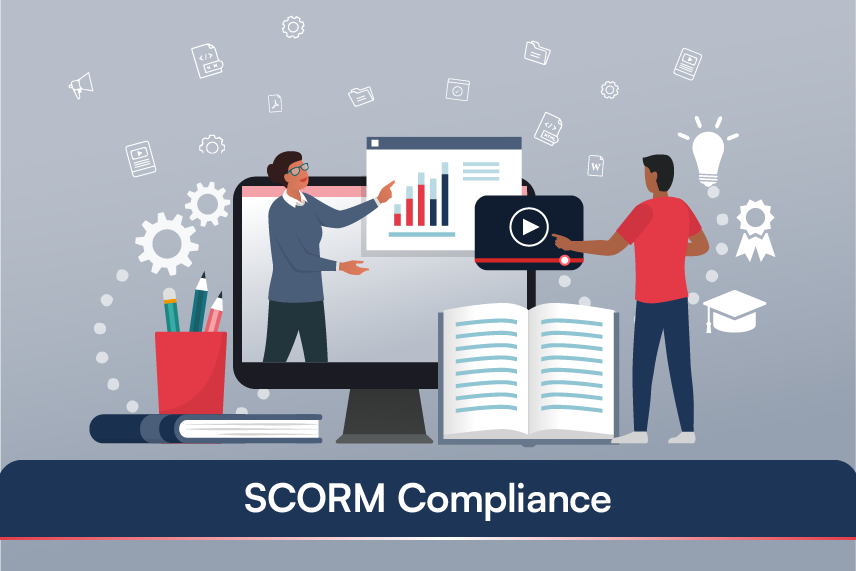
Table of Contents
Adopting a Sharable Content Object Reference Model or SCORM-compliant eLearning approach can be a game-changing move for organizations looking to create more productive, accelerated, and impactful L&D programs. With the advent of SCORM, the process of creating and delivering eLearning content has become more standardized and efficient.
SCORM compliance ensures eLearning courses are seamlessly integrated with various LMSs and provide a consistent learning experience across different platforms.
SCORM compliance offers various benefits such as:
- Easy content migration to new LMSs
- More options to use course elements
- More interactive learning experience
- Alignment with technology evolution to avoid expensive course redesign
- Reduced cost and time required to deliver training at scale
- Customized content to meet individual or organizational learning needs
Let’s delve into the intricacies of designing SCORM-compliant eLearning courses for effective training.
Understanding SCORM: Foundation of Interoperable eLearning
Before delving into the design process, it’s essential to grasp the fundamentals of SCORM and its significance in eLearning development. SCORM is a compilation of technical standards that governs how eLearning content is packaged, delivered, and tracked across different LMSs. It ensures interoperability, allowing content to be easily shared and accessed across various LMSs without compatibility issues.
Key SCORM Components
Content Packaging: SCORM-compliant courses are typically packaged into ZIP files containing all necessary resources such as HTML files, multimedia elements, assessments, and metadata.
Run-Time Environment: It refers to the software environment in which SCORM-compliant eLearning content is executed and tracked. SCORM defines a run-time environment where eLearning content interacts with the LMS. This enables the tracking of learner progress, completion status, and performance data.
Sequencing and Navigation: SCORM provides guidelines for organizing content modules and defining the sequence of learning activities. It also standardizes navigation controls, ensuring a consistent user experience.
Steps to Design SCORM-Compliant eLearning Courses

Designing SCORM-compliant eLearning courses requires careful planning, attention to detail, and adherence to industry standards. Here’s a step-by-step guide to help you create effective and interoperable training content that is SCORM compliant:
Step 1: Define Learning Objectives
Begin by clearly defining the learning objectives that you aim to achieve with your eLearning course. Learning objectives should be specific, measurable, achievable, relevant, and time bound. They serve as a roadmap for course development and help align content with desired learning outcomes.
Step 2: Structure Content
Organize your course content into logical modules and lessons. Create a hierarchy that facilitates easy navigation and ensures a cohesive learning experience. Each module should focus on a specific subject or learning objective, with clear transitions between sections.
Step 3: Select Appropriate Multimedia Elements
Enhance engagement and comprehension by incorporating multimedia elements such as videos, images, audio clips, and interactive simulations. Ensure multimedia assets are relevant to the content and support the learning objectives. Optimize media files for compatibility and accessibility across different devices and platforms.
Step 4: Develop Interactive Assessments
Integrate formative and summative assessments throughout the course to evaluate learner progress and comprehension. Use a range of assessment formats, including multiple-choice questions, quizzes, simulations, and scenario-based activities. Align assessments with learning objectives and provide timely feedback to reinforce learning.
Step 5: Incorporate SCORM Metadata
Include SCORM metadata within your course package to provide essential information about the content, such as title, description, author, keywords, and copyright information. Metadata enhances searchability, interoperability, and reusability of eLearning content across different systems.
Step 6: Implement SCORM Tracking Mechanisms
This helps monitor learner interactions and performance within the course. Trackable data may include completion status, time spent on activities, quiz scores, and learner progress. Ensure compatibility with SCORM-compliant LMSs for accurate tracking and reporting.
Step 7: Test and Validate
Thoroughly test your SCORM-compliant eLearning course to identify any technical or compatibility issues. Validate the course package using SCORM-compliant testing tools to ensure compliance with industry standards. Conduct usability testing with representative learners to gather feedback and make necessary adjustments.
Step 8: Package and Distribute
Once your eLearning course is finalized and validated, package it into a SCORM-compliant format (typically a ZIP file). Upload the course package to your LMS or eLearning platform, ensuring compatibility with SCORM specifications. Provide clear instructions for learners on accessing and navigating the course content.
Want to know how Harbinger redeveloped and migrated non-SCORM legacy courses to ALM for a leading alternative investment platform?
Best Practices for Designing SCORM-Compliant eLearning Courses
Apart from the steps outlined above, consider implementing the following best practices to optimize the design and delivery of your SCORM-compliant eLearning courses:
Maintain Accessibility: Ensure your eLearning content is accessible to learners with disabilities by adhering to accessibility standards such as WCAG 2.2. Leverage eLearning accessibility solutions to not only comply with the latest accessibility standards but also create inclusive learning experiences.
Optimize for Mobile Devices: Design courses with responsive layouts and scalable content to accommodate learners accessing the training on various devices, including smartphones and tablets.
Personalize Learning Paths: Offer flexibility and customization options that allow learners to choose their learning paths based on individual preferences and skill levels.
Foster Interactivity and Engagement: Incorporate interactive elements, gamification features, and collaborative activities to promote active engagement and knowledge retention.
Regularly Update Content: Keep your eLearning content relevant and up to date by regularly reviewing and modifying course materials to reflect changes in technology, industry trends, and best practices.
By following the steps outlined above and embracing the best practices, you can create engaging, effective, and interoperable training experiences that empower learners to succeed.
Start Designing
The ultimate goal of SCORM compliance is to facilitate seamless integration, interoperability, and tracking of eLearning content across different platforms, ensuring a consistent and impactful learning experience for all stakeholders involved. With careful planning and attention to detail, along with creativity, you can master the art of designing SCORM-compliant eLearning courses that drive organizational success and empower learners to achieve their goals.
Harbinger has been helping clients in over 65 countries design SCORM-compliant eLearning courses for effective training. We would be happy to discuss your SCORM compliance requirements and how our expertise can meet them. Get in touch with our eLearning experts.






